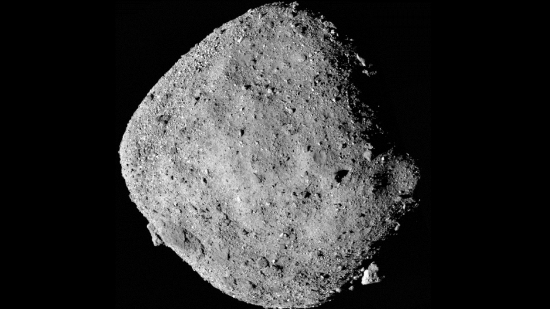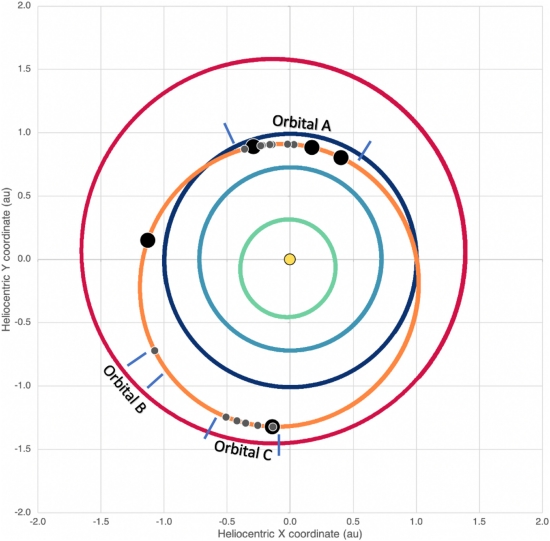OSIRIS-REx, the little spacecraft with the big acronym (standing for Origins, Spectral Interpretation, Resource Identification, and Security-Regolith Explorer) has been on station for a year and a half at asteroid Bennu, monitoring the unexpected activity that distinguishes the object. Particle ejection from the surface is the subject of a revised special issue of the Journal of Geophysical Research: Planets collecting 10 papers on the matter.
Specifically, the spacecraft has found that particles of rock mostly of pebble-size are being ejected repeatedly — one or two per day — from the asteroid’s surface, some of them escaping into space, some moving into a temporary orbit, with the rest falling back onto the surface. Just days after entering orbit on December 31 of 2018, OSIRIS-REx began to spot the activity, which the introduction to the special issue refers to as “ongoing mass shedding” involving millimeter- to centimeter-scale particles. What we have on our hands here is an asteroid that is active.
Dante Lauretta (University of Arizona) is OSIRIS-REx principal investigator:
“We thought that Bennu’s boulder-covered surface was the wild card discovery at the asteroid, but these particle events definitely surprised us. We’ve spent the last year investigating Bennu’s active surface, and it’s provided us with a remarkable opportunity to expand our knowledge of how active asteroids behave.”

Image: This mosaic image of asteroid Bennu is composed of 12 images collected on Dec. 2, 2018, by the OSIRIS-REx spacecraft’s PolyCam instrument from a range of 24 kilometers. Credit: NASA/Goddard/University of Arizona.
Bennu is another example of the blurring of the distinction between comets and asteroids, the former composed of ice, rock and dust and subject to heating by the Sun during the approach to perihelion that causes the formation of the familiar tail as vapor and dust is carried into space. The rock and dust characteristic of asteroids wouldn’t seem to lend itself to such activity, but the papers here point to thermal fracturing that is the result of repeated heating and cooling as the object rotates as the likely driver. Also implicated: Impacts from meteoroids hitting the surface. From a paper on thermal fatigue by Jamie Molaro (Planetary Science Institute) and colleagues:
If thermal fatigue indeed plays a role in Bennu’s activity, this has broad implications for our understanding of active asteroids and the asteroid population as a whole. Previous works have hypothesized that thermal fracture processes may generate activity on active asteroids with small perihelion distances, such as (3200) Phaethon (Jewitt & Li, 2010). Our results support this hypothesis. With a diurnal temperature variation of hundreds of degrees, Phaethon’s surface is likely to be subject to thermal shock processes, with fatigue operating at depth to weaken and prepare the rock for disruption. However, the fact that thermal fatigue alone may be capable of generating activity suggests that there may be many more active asteroids than are currently known, likely including many in near?Earth space. With less energetic activity, a lack of tails or comae would make such bodies hard to identify from ground?based observations, and previous missions to visit asteroids up close lacked the capability to detect ejection events like those observed on Bennu.

Image: Occurrence of particle ejection events (circles) in the orbit of Bennu (orange). Ejection events of 2 to 19 particles are denoted by small gray circles; events of 20 or more particles are denoted by large black circles. The phases of the OSIRIS?REx mission that included dedicated particle monitoring (Orbitals A–C) are indicated with blue hatches. The Sun (yellow) and the orbits of Mercury (green), Venus (light blue), Earth (dark blue), and Mars (red) are also shown for reference. Credit: Hergenrother et al. (2020).
Mission scientists have been able to use the unexpected stream of particles as a probe of the asteroid’s gravitational field, for many of them were found to be orbiting much closer than the spacecraft itself, their trajectories sensitive to the irregular gravity of the object. The precision of the measurement is actually higher than would have been possible solely through the instruments aboard OSIRIS-REx. Chesley calls them “an unexpected gift for gravity science at Bennu since they allowed us to see tiny variations in the asteroid’s gravity field that we would not have known about otherwise.”
Remember that this is a sample return mission, with a touchdown planned for October 20 to gather surface material, some of which may contain particles that were ejected and have fallen back to the surface. We can look forward to the spacecraft’s return in September of 2023.
The papers on Bennu are gathered in “Exploration of the Activity of Asteroid (101955) Bennu,” a special edition of the Journal of Geophysical Research: Planets first published in April of 2020 and now updated as of 19 August. The paper quoted above is Molaro et al., “Thermal Fatigue as a Driving Mechanism for Activity on Asteroid Bennu,” JGR Planets 21 July 2020 (abstract).



It always seems to me that it is just me, but I am often surprised as to why everybody considers physical phenomena to be rigidly defined. In other words asteroids must always be solid bodies with absolutely no volatiles whatsoever in them and comets must ALWAYS be composed of totally a mix of volatile compounds and a small amount of rock.
Why shouldn’t an asteroid have a small amount of volatiles present in its composition if it wants to? Who made up a rule that it must be absolutely bone dry with nothing in it but pebbles and dry dust and so forth. Yet the scientific papers express absolute surprise that there can be a little bit of outgassing from these bodies. Why should that be? That’s how I’m always surprised how these people can call themselves scientists; it seems like if they were scientists they would engage in a bit more of imagination as to what is possible are not possible. Color me surprised.
I am not sure where you got the idea that asteroids are “bone dry”. Many asteroids contain small amounts of volatiles, like water. It is one of the extractable materials that is often mentioned in asteroid mining.
There are also asteroids that are dead comets, where their volatiles are exhausted, leaving just [mainly?] the rock. Clearly there must be a period where the comet becomes ever more rocky in composition, connecting the concepts of comet and asteroid, rather than these being extreme binary classifications.
Ryugu is very similar in shape and surface features to Bennu. Does that imply it also ejects pebbles/rock fragments that either are lost or fall back onto the surface? Is there any way to tell from samples. or does it require direct observation?
If rock fragments are ejected, does that mean that there is a stream of such fragments in the same orbit as Bennu, and that they would create meteor showers if they were to impact an atmosphere? Is the loss of material resulting in a slow loss of mass from Bennu that would slowly increase its orbital radius? How long before it would be eroded to nothing? If there is any material differentiation in Bennu, does this mechanism slowly expose the deeper layers towards its core?
A cumulation of mass carries in its structure a history of its origins and its subsequent viccisitudes. A solid chunk of a core would suggest a melding together under pressure and or heat from impact or gravitational forces. A covering of loose material, if identical to the core, would suggest thermal or other radiative fracturinng, or perhaps impact from identical material. Otrerwise it could be from accretion.
One ‘Oumuamua could be worth a thousand comets & asteroids.
“One ‘Oumuamua could be worth a thousand comets & asteroids.”
Yes, it is, which is why we must get a mission to it, even if it does take decades:
https://centauri-dreams.org/2017/11/10/project-lyra-sending-a-spacecraft-to-1ioumuamua-formerly-a2017-u1-the-interstellar-asteroid/
It “could” be, or then again, it could not. Unless we have a lot more resources, is it better to chase down this visitor or to do other desirable planetary missions? Now if we could actually defund some of the military and use it for space missions, then I would agree, this might be worth a “blue sky” shot.
Rosetta’s Philae Lander Was Alive on the Surface of 67P for 63 Hours, Trying to Communicate
BY EVAN GOUGH
SEPTEMBER 9, 2020
In August 2014, the ESA’s Rosetta spacecraft arrived at its destination, Comet 67P/Churyumov-Gerasimenko, after a 10 year journey. Rosetta carried a small companion, the Philae Lander. On November 12th, Philae was sent to the surface of Comet 67P. Unfortunately, things didn’t go exactly as planned, and the lander’s mission lasted only 63 hours.
During that time, it gathered what data it could. But mission scientists weren’t certain of its precise location, meaning its data was difficult to interpret accurately. Only when scientists knew precisely where Philae was located on the comet, could they make best use of all of its data.
Rosetta was the third mission in the ESA’s Horizon 2000 program. On its way to Comet 67P, it performed flybys of Earth and Mars, and of two other asteroids. But Comet 67P was its target, and it was the first spacecraft to ever orbit a comet. And the Philae lander was the first spacecraft to land on a comet.
Full article here:
https://www.universetoday.com/147684/rosettas-philae-lander-was-alive-on-the-surface-of-67p-for-63-hours-trying-to-communicate/
I was told the reason the harpoons did not work on Philae was that the day they were to be tested, some VIP visited the ESA facility and the staff had to focus on accommodating them. Hopefully the agency has learned from this eff up, if it is true.
Why Scooping a Sample from an Asteroid is Harder than it Looks
Here’s what will happen on Oct. 20, when NASA’s OSIRIS-REx spacecraft will descend to asteroid Bennu and pick up a sample of pristine material left over from the formation of our solar system.
By Daniel Stolte, University Communications
Thursday, October 15, 2020
https://news.arizona.edu/story/why-scooping-sample-asteroid-harder-it-looks
SWRI tests “Clockwork Starfish” for sampling asteroids
October 16, 2020
https://room.eu.com/news/swri-tests-clockwork-starfish-for-sampling-asteroids
TAG, Bennu, you’re it
On Tuesday, NASA’s OSIRIS-REx spacecraft will attempt to touch down on the surface of asteroid Bennu and collect samples for return to Earth. Jeff Foust reports on how this effort, already technically challenging, has turned out to be even more difficult than originally expected.
https://www.thespacereview.com/article/4050/1